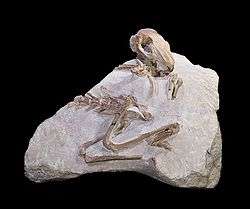Palaeolagus
| Palaeolagus Temporal range: Oligocene[1] | |
|---|---|
 | |
| Palaeolagus haydeni | |
| Scientific classification | |
| Kingdom: | Animalia |
| Phylum: | Chordata |
| Class: | Mammalia |
| Order: | Lagomorpha |
| Family: | Leporidae |
| Subfamily: | Palaeolaginae |
| Genus: | Palaeolagus Leidy, 1856 |
| Species | |
| |
Palaeolagus ('ancient hare') is an extinct genus of lagomorph.[2] Palaeolagus lived in the Oligocene period which was about 33-23 million years ago. The earliest leporids described from the fossil record of North America and Asia date to the upper Eocene some 40 million years ago. Selective pressure ostensibly drove them to become ever faster and better at running and jumping. Other fossil finds from Asia indicate more primitive progenitors of Palaeolagus existed in the lower Eocene; this pushes the likely date of divergence of rabbit-like and rodent-like lagomorphs back to more than 50 million years ago.
The 25 centimetres (9.8 in) long creature closely resembled modern rabbits. However, it had shorter hind limbs than living rabbits, suggesting that it was probably unable to hop, and would have instead moved in a creeping fashion similar to a ground squirrel.[1] They were common herbivorous inhabitants of the savanna, plains and woodlands of North America 30 million years ago.

The fossil remains of rabbits are scanty and those specimens that have been found are often too fragmentary to determine satisfactory the relationship with living forms. The bones of rabbits and hares are lightweight and fragile in structure, and so they are not easily preserved as fossils. Most of the species are inhabitants of uplands where conditions are not ideal for preservation. In a few deposits, rabbit remains seem numerous but many fossil species are known only from a few teeth and bones.
References
- 1 2 Palmer, D., ed. (1999). The Marshall Illustrated Encyclopedia of Dinosaurs and Prehistoric Animals. London: Marshall Editions. p. 285. ISBN 1-84028-152-9.
- ↑ Haaramo, Mikko (2008-03-11). "Mikko's Phylogeny archive". Retrieved 2009-02-01.